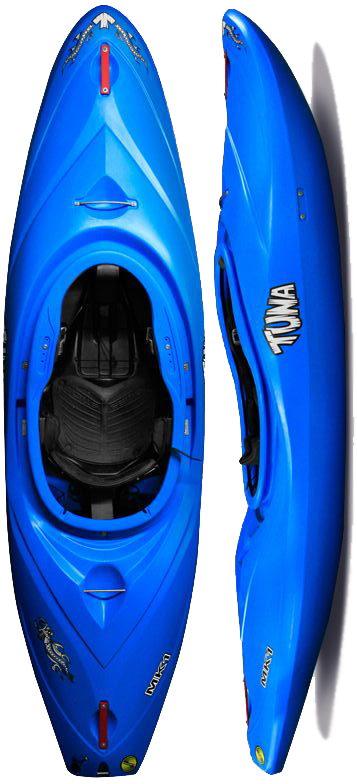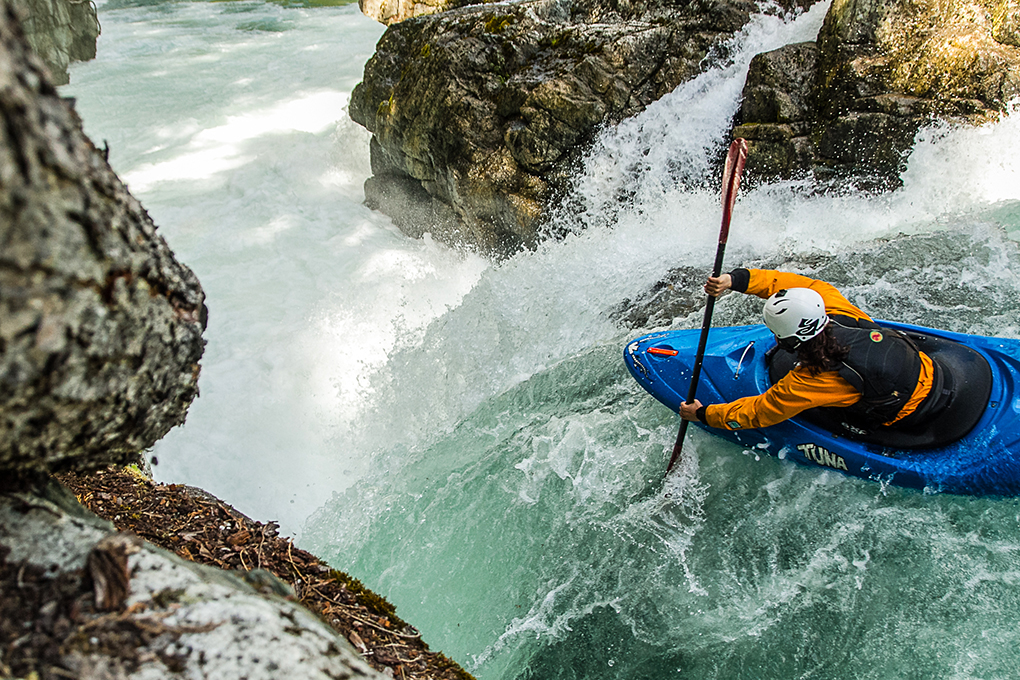
Bliss Stick / Waka Kayaks Tuna
Bliss-Stick Specs
Length: 8’6”
Width: 26.5”
Volume: 78 Gallons
Weight: 46 lbs.
Suggested Weight Range: 120lbs-250lbs
MSRP: $1149 USD
Waka Kayaks Specs
Length: 2590mm = 8’6”
Width: 675mm = 26.575”
Volume: 300 litres = 79.3 gallons
Weight: 21kg = 46.3lbs
Suggested Weight Range: 60-120kg (~130-260lbs)
MSRP: Waka doesn’t list an MSRP on their website, but European dealers are selling them for a base price of 1100 Euros. The shipment of Waka Tunas that made it to the US sold for $1100 USD each.
Reviewer:
5’10”, 160 lbs
Shoe Size: 10
Inseam: 31”
Test Locations: All over the US and Canada, Ecuador.
Test Conditions: Everything from class II up through big water class V+ and steep creeking.
Background (Wait, Two Manufacturers?)
Bliss-Stick (a New Zealand company) originally designed and manufactured the Tuna, but Sam Sutton bought the mold from them in 2013 and brought it to the Czech Republic under the name Waka Kayaks. They’ve been manufacturing the boat there since, and distribution in Europe seems to be going well. Distribution in North America has been very limited.
I write this review based on having paddled Bliss-Stick Tunas over the last few years, but they are built in the same mold with slightly different outfitting and a different plastic compound.
Design
Over the last few years, kayak companies have been experimenting with adding more and more rocker to their designs (Exhibit A: the Liquid Logic Stomper). These boats have been interesting to paddle; they are incredibly easy to boof, but slower and more challenging to hold a line with than some of their older, less rockered counterparts.
The Tuna was one of the first boats to find a compromise between increased rocker and speed & tracking, and it did so by making the front and rear rocker and hull profiles completely different from each other. Place the Tuna next to a Stomper, and you’ll see that the bow is quite similar: plenty of rocker, and a soft, round displacement-style hull.

But follow the design back toward the stern and you’ll see two things. First, the stern has dramatically less rocker than the bow, which helps keep speed up when paddling hard. Second, starting beneath the seat, the hull transitions to a planing hull with sharp edges and a flat bottom.

What does this mean when you’re paddling it? Well, the bow rocker makes it easy to boof. More than that, the rounded displacement hull of the bow allows you to essentially lift your bow onto things from the side, something that’s much more difficult in more traditional planing-hulled boats like the Pyranha Burn or the pre-2015 Jackson Zen. (More on this when I discuss big water.)
The sharp edges on the stern make the Tuna a high-performance machine that can whip in and out of eddies and make challenging ferries—if you learn how to use them. It paddles almost like a slalom boat—obviously, at my weight, I’m not dipping the stern under on eddy turns, but the feel is very similar.
The caveat is that the kind of paddling its design necessitates can take a lot of getting used to, and may not be for everyone. The sharp edges on the stern mean that as you’re peeling out, nothing happens until your seat crosses the eddyline. Once you cross that critical point, though, the edge engages and the boat whips downstream at lightning speed.
The same applies for pulling into eddies, and the stern profile actually makes paddling into eddies incredibly fun—something that helps make this boat one of my favorites to paddle on easier whitewater. As you cross into an eddy with speed, the boat transitions onto the flat stern and allows an incredible amount of control with rudder strokes as you fly into the eddy. It’s a feeling akin to making ski turns in deep pow. This is especially apparent in stronger eddies, and those with big eddy-fences.
Creekboating
The Tuna’s aggressive bow-rocker makes it a great boat for rivers where the majority of your strokes are boof strokes. In some ways, it’s similar to the Stomper in that you hardly even need to take a stroke for it to boof—though, of course, you’re generally better off if you do.
The lack of edges on the front of the boat allow it to smear off rocks and cruise downstream without trouble, so long as you’re in control and where you want to be.
I have found, however, that the sharp stern edges can easily catch you off guard if you’re not paying attention, or if you get off line. The biggest criticism of planing hull boats since they first hit the market has been that their edges are sharp and get caught on things, and the Tuna is no exception. In fact, because the edges on the Tuna are behind the seat position, it can be jarring and can easily knock you off line or flip you when they catch.
Additionally, the sharp edges and vertical sidewall of the boat can cause some challenging things to happen when boofing off the side of rocks. First, as your body passes the rock, the stern edge begins to catch, making it challenging to transition to flat, especially on smaller boofs with less air time.
Second, when you land on edge (which often happens—see the previous paragraph), you’re landing on the very flat sidewall which provides some stability, but again makes for a more difficult transition to flat than boats with a more displacement-style hull. This can occasionally cause you to catch the downstream edge in the eddy-water you’re boofing into.
I’ve gained a strong appreciation for watery boofs from paddling this boat, and tend to hit those rock boofs a little lower than I would in a more rounded kayak. This isn’t necessarily a bad thing, but it takes some getting used to.
If you only paddle steep, low-volume creeks, or like to relax and float through stuff from time to time, the Tuna is probably not the best boat, but it certainly holds its own and can paddle steep creeks extremely well when driven properly.
NEXT: Big Water, Speed, Sizing, Etc.

Interesting mixed review. I live in NZ and so paddled the original Bliss-Stick Tuna and now have the Waka Tuna. Without a doubt the best boat out there! I have had a Mamba,Stomper, Mystic and Burn before but just ended up craving the carving ability of the Tuna. The outfitting is simple and the most comfortable i’ve been in. It performs on all the whitewater NZ has to offer. And the Waka kayaks are super strong and durable. In regards to the grabby rear rail you keep mentioning, it paddles better with the seat slightly forward (a comment resonated by Kenny Mutton who designed the boat). And if you are using them properly they dont grab at all, just carve around like good fun! It is a boat for a paddler with a bit of style and finesse rather than smashing down stuff like you can get away with in a stomper/nomad/jefe. If you nail the line from the start you will go through it with a bunch of steeze (check out the likes of Aniol, Evan, Sven and Sam. All the styliest paddlers out there). But, for sure, it is fast so if you come off line you need to react fast. That being said, if you sit it flat it spins super easy on the spot and then just engage the rail and hoon off again (it was based slightly off a playboat hull just btw). You can pull one stroke up onto a lateral and hold the rail until you want to turn then sit it flat, spin, transition and skim into your next line. Once you get used to it you will never settle for anything else.
To sum it all up,
SMOOTH, STEEZY, FAST, and feels like SEX